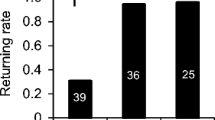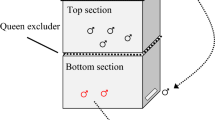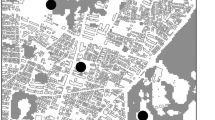Abstract
The role of learning to navigate toward a specific location has been extensively studied in the foraging context of social hymenopteran females, which bring resources to the colony. On the contrary, empirical field studies on learning in other behavioral contexts are scarce, particularly in the context of mating. Apis mellifera males (drones) do not forage for themselves and/or for their colony, but they only return to their colony to refuel if they were unsuccessful in mating with a female. In the present study, to test whether homing in drones results from learning the landscape around their hives, we compared the homing success between drones released at sites that were familiar to them (resident group) and those released at unfamiliar sites (transported group). Drones from the resident group were able to return to their hive, whereas those from the transported group could not, with the exception of a few drones that were released close to the sites that offered direct visual information for the drones to return to the hives. These results indicate that drones learn about their hives and the surrounding landscape during their flights.




Similar content being viewed by others
References
Becker L (1958) Untersuchungen über das Heimfindevermögen der Bienen. Zeitschrift für Vergleichende Physiol 41:1–25
Bitterman ME, Menzel R, Fietz A, Schäfer S (1983) Classical conditioning of proboscis extension in honeybees (Apis mellifera). J Comp Psychol 97:107–119
Capaldi EA, Dyer FC (1999) The role of orientation flights on homing performance in honeybees. J Exp Biol 202:1655–1666
Capaldi EA, Smith AD, Osborne JL, Fahrbach SE, Farris SM, Reynolds DR, Edwards AS, Martin A, Robinson GE, Poppy GM, Riley JR (2000) Ontogeny of orientation flight in the honeybee revealed by harmonic radar. Nature 403:537–540
Chittka L, Beier W, Hertel H, Steinmann E, Menzel R (1992) Opponent colour coding is a universal strategy to evaluate the photoreceptor inputs in Hymenoptera. J Comp Physiol A 170:545–563
Collett M, Chittka L, Collett TS (2013) Spatial memory in insect navigation. Curr Biol 23:R789–R800
Collett TS, Collett M (2002) Memory use in insect visual navigation. Nat Rev Neurosci 3:542–552
Currie RW, Jay SC (1991) The influence of a colony’ s queen state the drifting of drone honey bees (Apis mellifera). Apidologie 22:183–195
Fahrbach SE, Giray T, Robinson GE (1995) Volume changes in the mushroom bodies of adult honey bee queens. Neurobiol Learn Mem 63:181–191
Galindo-Cardona A, Monmany AC, Diaz G, Giray T (2015) A landscape analysis to understand orientation of honey bee (Hymenoptera: Apidae) drones in Puerto Rico. Environ Entomol 44:1139–1148
Galindo-Cardona A, Monmany AC, Moreno-Jackson R, Rivera-Rivera C, Huertas-Dones C, Caicedo-Quiroga L, Giray T (2012) Landscape analysis of drone congregation areas of the honey bee, Apis mellifera. J Insect Sci 12:1–15
Hayashi S, Farkhary SI, Takata M, Satoh T, Koyama S (2017) Return of drones: flight experience improves returning performance in honeybee drones. J Insect Behav 30:237–246
Howell DE, Usinger RL (1933) Observations on the flight and length of life of drone bees. Ann Entomol Soc Am 26:239–246
Ichikawa N, Sasaki M (2003) Importance of social stimuli for the development of learning capability in honeybees. Appl Entomol Zool 38:203–209
Lichtenstein L, Sommerlandt FMJ, Spaethe J (2015) Dumb and lazy? A comparison of color learning and memory retrieval in drones and workers of the buff-tailed bumblebee, Bombus terrestris, by means of per conditioning. PLoS One 10:1–18
Loper GM, Wolf WW, Taylor ORJ (1992) Honey bee drone flyways and congregation areas: radar observations. J Kansas Entomol Soc 65:223–230
Menzel R, Brandt R, Gumbert A, Komischke B, Kunze J (2000) Two spatial memories for honeybee navigation. Proc R Soc B Biol Sci 267:961–968
Oertel E (1956) Observations on the flight of drone honey bees. Ann Entomol Soc Am 49:497–500
Page REJ, Metcalf RA (1984) A population investment sex ratio for the honey bee (Apis mellifera L.). Am Nat 124:680–702
R Core Team (2017) The R: project for statistical computing. https://www.r-project.org/
Reyes M, Crauser D, Prado A, Le Conte Y (2019) Flight activity of honey bee (Apis mellifera) drones. Apidologie 50:669–680
Robert T, Frasnelli E, Collett TS, de Ibarra NH (2017) Male bumblebees perform learning flights on leaving a flower but not when leaving their nest. J Exp Biol 220:930–937
Robert T, Frasnelli E, De Ibarra NH, Collett TS (2018) Variations on a theme: bumblebee learning flights from the nest and from flowers. J Exp Biol 221:jeb172601
Seeley TD (1985) Honeybee ecology: a study of adaptation in social life. Princeton University Press
Witherelli PC (1971) Duration of flight and of interflight time of drone honey bees, Apis mellifera. Ann Entomol Soc Am 64:609–612
Wolf S, Chittka L (2016) Male bumblebees, Bombus terrestris, perform equally well as workers in a serial colour-learning task. Anim Behav 111:147–155
Zmarlicki C, Morse RA (1963) Drone congregation areas. J Apic Res 2:64–66
Acknowledgments
We sincerely thank all members of the Ethology Laboratory in TUAT for providing valuable suggestions regarding this study and for valuable discussions.
Author information
Authors and Affiliations
Corresponding author
Additional information
Publisher’s note
Springer Nature remains neutral with regard to jurisdictional claims in published maps and institutional affiliations.
Rights and permissions
About this article
Cite this article
Hayashi, S., Satoh, T. Landscape Learning during Flight Ensures Homing in Honey Bee (Apis mellifera) Drones. J Insect Behav 34, 82–88 (2021). https://doi.org/10.1007/s10905-021-09771-3
Received:
Revised:
Accepted:
Published:
Issue Date:
DOI: https://doi.org/10.1007/s10905-021-09771-3




